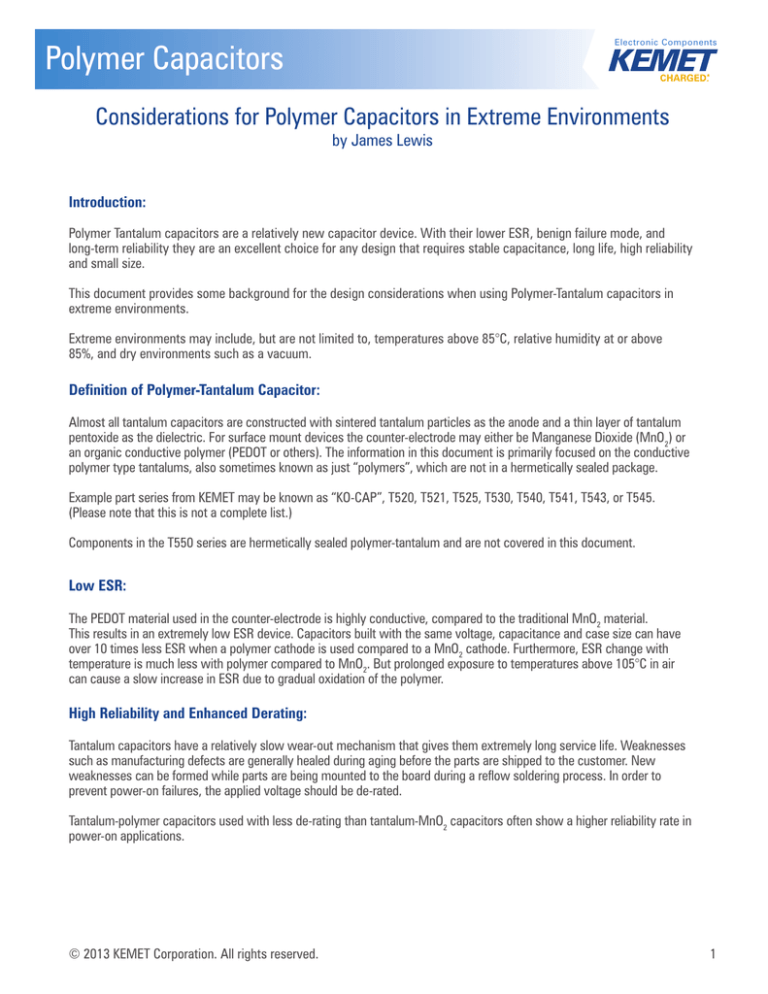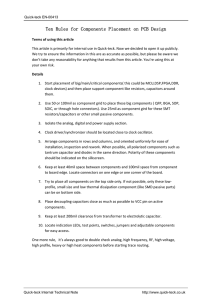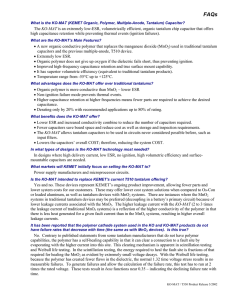
Electronic Components
Polymer Capacitors
Considerations for Polymer Capacitors in Extreme Environments
by James Lewis
Introduction:
Polymer Tantalum capacitors are a relatively new capacitor device. With their lower ESR, benign failure mode, and
long-term reliability they are an excellent choice for any design that requires stable capacitance, long life, high reliability
and small size.
This document provides some background for the design considerations when using Polymer-Tantalum capacitors in
extreme environments.
Extreme environments may include, but are not limited to, temperatures above 85°C, relative humidity at or above
85%, and dry environments such as a vacuum.
Definition of Polymer-Tantalum Capacitor:
Almost all tantalum capacitors are constructed with sintered tantalum particles as the anode and a thin layer of tantalum
pentoxide as the dielectric. For surface mount devices the counter-electrode may either be Manganese Dioxide (MnO2) or
an organic conductive polymer (PEDOT or others). The information in this document is primarily focused on the conductive
polymer type tantalums, also sometimes known as just “polymers”, which are not in a hermetically sealed package.
Example part series from KEMET may be known as “KO-CAP”, T520, T521, T525, T530, T540, T541, T543, or T545.
(Please note that this is not a complete list.)
Components in the T550 series are hermetically sealed polymer-tantalum and are not covered in this document.
Low ESR:
The PEDOT material used in the counter-electrode is highly conductive, compared to the traditional MnO2 material.
This results in an extremely low ESR device. Capacitors built with the same voltage, capacitance and case size can have
over 10 times less ESR when a polymer cathode is used compared to a MnO2 cathode. Furthermore, ESR change with
temperature is much less with polymer compared to MnO2. But prolonged exposure to temperatures above 105°C in air
can cause a slow increase in ESR due to gradual oxidation of the polymer.
High Reliability and Enhanced Derating:
Tantalum capacitors have a relatively slow wear-out mechanism that gives them extremely long service life. Weaknesses
such as manufacturing defects are generally healed during aging before the parts are shipped to the customer. New
weaknesses can be formed while parts are being mounted to the board during a reflow soldering process. In order to
prevent power-on failures, the applied voltage should be de-rated.
Tantalum-polymer capacitors used with less de-rating than tantalum-MnO2 capacitors often show a higher reliability rate in
power-on applications.
© 2013 KEMET Corporation. All rights reserved.
1
Polymer Capacitors
Electronic Components
MSL Rating:
The polymer material used in these capacitors is hygroscopic. For this reason before parts are mounted to a PCB, they
should be treated as MSL 3 (or higher) components. Parts that are not handled to MSL 3 may “popcorn” during the reflow
process, damaging the capacitive element.
High Humidity:
Polymer capacitors often cannot pass 1,000 hour life tests in conditions of 85°C while at 85% relative humidity.
Currently, all capacitor manufacturers who produce products similar to KEMET’s polymer capacitors, qualify their polymer
components at 60°C with 90% RH for 500 hours. Components from KEMET include details for each series in their respective
catalogs under the section “Qualification.”
When exposed to excessive humidity, the polymer cathode’s ESR will begin to increase. This effect is generally not reversible.
Low Humidity:
Conditions that can cause the capacitor to completely dry out, such as operation in a vacuum or during reflow soldering,
may cause the capacitor to exhibit an anomalous charging behavior.
This anomalous charging behavior will result in the amount of time and energy necessary to charge the capacitor being
much greater than the theoretical charge time.
It should be noted that this is not considered a failed condition, but may cause undesired circuit behavior.
As the capacitor reabsorbs atmospheric moisture, the charge time required for a capacitor exhibiting this behavior will
return to normal. Typically 24-48 hours after reflow soldering the affected capacitors will behave much more normally.
When a very dry polymer exhibits this behavior it is possible to achieve more normal behavior by charging the capacitor
while it is above 65°C and then allowing it to cool below +35°C while still charged. After this treatment, the very dry
capacitor will only exhibit the behavior again after it is cooled from >65°C while discharged.
For more information on this anomalous charging behavior, please contact your local KEMET representative or Field
Application Engineer.
Conclusion:
As long as considerations for extreme temperatures and humidity are taken into account, tantalum-polymer capacitors
offer a number of advantages over other capacitor types when used in extreme environments.
KEMET continues to investigate the behaviors of polymer-tantalum capacitors in extreme environments. If you have
questions about using these capacitors in a specific environment or specific application, we suggest you contact your
local representative or Field Application Engineer to discuss the specific details of your application.
For more information on this product go to http://www.kemet.com/kocap or scan the QR code:
© 2013 KEMET Corporation. All rights reserved.
2





